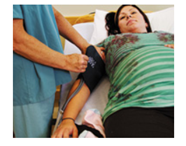
38-Year-Old Female with Preeclampsia
Ms. Johansen, 38, is 26 weeks pregnant with her first child. She was diagnosed with preeclampsia (see p. 1114) three weeks ago. Antihypertensive drugs (p. 724) and daily home care monitoring were initiated. However, her blood pressure is continuing to rise and is now 162/108 mm Hg. She complains of a constant headache, exhibits edema, and her urinalysis is positive for protein.

Her doctor has her admitted and orders further blood tests to assess Ms. Johansen's platelet level and liver function. "We may have to deliver because that’s the only cure for preeclampsia." she says to you during your clinical rotation in obstetrics. “But if we do, then the baby will have problems. It’s a tough decision because we have to balance both the mother's and the baby’s health.”
1. Although blood volume increases during pregnancy, blood pressure normally decreases. You know that blood pressure depends on cardiac output (CO) and total peripheral resistance (TPR) (Figure 19.10, p. 719). How does increased blood volume affect CO, and what factor(s) must change so that blood pressure decreases?
Want to see the full answer?
Check out a sample textbook solution
Chapter 28 Solutions
Human Anatomy & Physiology Plus Mastering A&P with Pearson eText -- Access Card Package (11th Edition) (What's New in Anatomy & Physiology)
- Patient M., 36 y/o, was found in the street unconscious. The patient has a medical history of diabetes. There is a smell of alcohol from the mouth. The skin is moist, warm, arterial pressure -145/90 mm column of mercury, convulsive twitching of muscles. Breathing is shallow, eye ball tone is retained, pupils are dilated, hyperflexion. How would you treat this patients?A. Intravenous introduction of 40-80-100 ml 40% glucose solution B. Injecting 20 units of insulin subcutaneouslyC. Injecting 20 units of insulin intravenouslyD. Injecting 500 ml 5% glucose solution intravenouslyE. Injecting 500 ml 0.9% sodium chloride intravenouslyarrow_forwardM.H. is an 80-year-old Caucasian female who is married and lives with her spouse. She presents to your office today with her spouse, feeling “coocoo, I just don’t feel right.” Currently she is taking rosuvastatin prescribed by her cardiologist for hyperlipidemia and a daily 325 mg aspirin. She drinks 3–6 hard liquor drinks a day, 3–4 times a week in the evening, and has a 65-year smoking habit, currently smoking two packs per day (ppd). She has no known allergies. Past surgical history includes hysterectomy for a benign fibroid. Family history of breast cancer in three sisters, Type 2 diabetes and CVA in one sister, cancer of unknown origin in one brother. All siblings and parents are deceased. Her husband reports that she is hard of hearing. He feels that it is due to cerumen build-up in her ears. She refuses to have the buildup removed. Her husband is also worried about her memory—states that she “just does not remember things like she used to. She keeps asking me the same questions…arrow_forwardMary Brown [MB] is a healthy 36-year-old woman with complaints of persistent generalized fatigue. At her annual checkup, her vital signs: heart rate (HR), 118 beats/min; blood pressure (BP), 110/60 mm Hg; oral temperature, 37°C; and respiratory rate (RR), 26 breaths/min. Her skin, conjunctiva and nail beds are pale. Laboratory results: hematocrit (Hct), 27%; hemoglobin (Hb), 9 g/dL and hypochromatic red blood cells (RBCs) are present. Which of MB’s clinical signs are reflective of the body’s effort to compensate for the decreased oxygen carrying capacity seen with this condition?arrow_forward
- Mary Brown [MB] is a healthy 36-year-old woman with complaints of persistent generalized fatigue. At her annual checkup, her vital signs: heart rate (HR), 118 beats/min; blood pressure (BP), 110/60 mm Hg; oral temperature, 37°C; and respiratory rate (RR), 26 breaths/min. Her skin, conjunctiva and nail beds are pale. Laboratory results: hematocrit (Hct), 27%; hemoglobin (Hb), 9 g/dL and hypochromatic red blood cells (RBCs) are present. MB is counseled to increase her dietary intake of iron-containing foods. What kinds of food would be recommended?arrow_forwardMary Brown [MB] is a healthy 36-year-old woman with complaints of persistent generalized fatigue. At her annual checkup, her vital signs: heart rate (HR), 118 beats/min; blood pressure (BP), 110/60 mm Hg; oral temperature, 37°C; and respiratory rate (RR), 26 breaths/min. Her skin, conjunctiva and nail beds are pale. Laboratory results: hematocrit (Hct), 27%; hemoglobin (Hb), 9 g/dL and hypochromatic red blood cells (RBCs) are present. What type of hematologic disorder would you suspect based on MB’s laboratory values? Why?arrow_forwardMr. Henry is a 50-year-old male who presents to the office for headaches. he has a known history of sinus infections when the seasons change, high blood pressure and depression. his medications include Lopressor 50mg, daily and Claritin 10mg daily. he has a family history significant for aneurysms and depression. His vitals are BP 196/86 right arm seated, HR 87 regular, RR 13, Temp 98 oral. What is a NANDA approved diagnosis you could give her?arrow_forward
- John Doe, 53y.o., has a history of Type I diabetes mellitus, cigarette smoking 40 pack-years, CAD, and PVD. Six weeks ago, he developed a wound in his left heel which measured 4cm by 2cm when he discovered it. Despite IV antibiotics and chemical debridement, the wound developed a gangrene infection. He is scheduled for a BKA of the left lower extremity tomorrow at 10:00 am. His meds include daily insulin, aspirin 325mg/day, Pletaal 100mg BID. Question: Preventing complications of surgery is an important part of all surgical patient care. What preoperative While Mr. Doe is in the Operating Room, what considerations will be taken to ensure Mr. Doe’s safety and positive outcome? Identify 2 IntraOp nursing diagnoses for Mr. Doe teaching does Mr. Doe require in order to prevent complications? Give 3-4 examples)arrow_forwardDescription A-45-year-old woman presents complaining of fatigue, 30 pounds of weight gain despite dieting, constipation, and menorrhagia. On physical examination, the thyroid is not palpable: the skin is cool, dry, and rough: the heart sounds are quiet; and the pulse rate is 50 bpm. The rectal and pelvic examinations show no abnormalities, and the stool is negative for occult blood. The clinical findings suggest hypothyroidism. Questions A. What other features of the history should be elicited? What other findings should be sought on physical examination? B. What is the pathogenesis of this patient's symptoms? C. What laboratory tests should be ordered, and what results should be anticipated? D. What are the possible causes of this patient's condition? Which is most likely? E. What other conditions may be associated with this disorder?arrow_forwardA 62-year old, recently widowed male Hispanic patient, KB. was brought in to the emergency department (ED) by his daughter for progressively worsening shortness of breath, fatigue, a lingering non-productive cough, and generalized edema. One month prior, he noticed dyspnea upon exertion, loss of appetite, nausea, vomiting and malaise, which he attributed to the flu. In the emergency department, he appeared anxious and pale, and had a dry yellow tint to the skin. He denied any chest pain, and he could not recall the last time he urinated. He has history of benign prostatic hyperplasia, diabetes mellitus type 2, hypertension, dyslipidemia, and renal insufficiency for the past two years. His ED assessment findings included: 1+ pedal edema, basilar crackles in the lungs bilaterally, and a scant amount of urine according to a bladder scan. His lab results indicated a glomerular filtration rate (GFR) of 12. Based on his subjective and objective symptoms, he was admitted with a diagnosis of…arrow_forward
- M. J. is a 76-year-old woman who lives on the side of a very steep mountain. The home health nurse has visited her once a week for the last year. She has running water, electricity, and a coal stove with back-up oil heat for very cold winter nights. She uses the telephone for communication. She has diabetes mellitus, hypertension, hypothyroidism, and is in atrial fibrillation. She has never been in the hospital before. Her current medications include metformin (250 mg twice a day), losartan (50 mg/day), levothyroxine sodium (Synthroid) (50 mcg/day), digoxin (0.125 mg/day), furosemide (Lasix) (10 mg/day), aspirin (81 mg/day), simvastatin (20 mg/day), and warfarin (Coumadin) (4 mg/day, with 6 mg on Sundays). Allergies are to penicillin (hives) and to metoprolol (hypotension and dizziness). M. J. stopped smoking 5 years ago, but until then she smoked one-half pack a day. Last laboratory test results (1 week ago) were: hemoglobin A1C (Hgb A1C) 8.3, international normalized ratio (INR) 1.7,…arrow_forwardM. J. is a 76-year-old woman who lives on the side of a very steep mountain. The home health nurse has visited her once a week for the last year. She has running water, electricity, and a coal stove with back-up oil heat for very cold winter nights. She uses the telephone for communication. She has diabetes mellitus, hypertension, hypothyroidism, and is in atrial fibrillation. She has never been in the hospital before. Her current medications include metformin (250 mg twice a day), losartan (50 mg/day), levothyroxine sodium (Synthroid) (50 mcg/day), digoxin (0.125 mg/day), furosemide (Lasix) (10 mg/day), aspirin (81 mg/day), simvastatin (20 mg/day), and warfarin (Coumadin) (4 mg/day, with 6 mg on Sundays). Allergies are to penicillin (hives) and to metoprolol (hypotension and dizziness). M. J. stopped smoking 5 years ago, but until then she smoked one-half pack a day. Last laboratory test results (1 week ago) were: hemoglobin A1C (Hgb A1C) 8.3, international normalized ratio (INR) 1.7,…arrow_forwardA 10-year-old boy with known HbSS disease presented to the Paediatric Emergency Department with a oneweek history of fever and severe pain in his right leg, severity 9/10 for the last two days. On examination:Pulse – 100 beats/min, BP – 110/70 mmHg, Capillary refill < 2sec and Respiratory rate – 20 breaths/ min. He has point tenderness anteriorly on proximal tibia. There is no joint swelling.X-ray of the affected limb shows marked periosteal elevation.His complete blood count is: Hb – 6.5 g/dL WBC 30 x 10 /L Plt – 120 x 10 /L with a reticulocyte count of 1%.Of the following the MOST appropriate management in this patient would bea. Ibuprofen, Cefotaxime and top-up transfusionb. Morphine, Ampicillin and hydration therapyc. Morphine, Cefotaxime and hydration therapyd. Morphine, Cefotaxime and top-up transfusionarrow_forward
 Human Anatomy & Physiology (11th Edition)BiologyISBN:9780134580999Author:Elaine N. Marieb, Katja N. HoehnPublisher:PEARSON
Human Anatomy & Physiology (11th Edition)BiologyISBN:9780134580999Author:Elaine N. Marieb, Katja N. HoehnPublisher:PEARSON Biology 2eBiologyISBN:9781947172517Author:Matthew Douglas, Jung Choi, Mary Ann ClarkPublisher:OpenStax
Biology 2eBiologyISBN:9781947172517Author:Matthew Douglas, Jung Choi, Mary Ann ClarkPublisher:OpenStax Anatomy & PhysiologyBiologyISBN:9781259398629Author:McKinley, Michael P., O'loughlin, Valerie Dean, Bidle, Theresa StouterPublisher:Mcgraw Hill Education,
Anatomy & PhysiologyBiologyISBN:9781259398629Author:McKinley, Michael P., O'loughlin, Valerie Dean, Bidle, Theresa StouterPublisher:Mcgraw Hill Education, Molecular Biology of the Cell (Sixth Edition)BiologyISBN:9780815344322Author:Bruce Alberts, Alexander D. Johnson, Julian Lewis, David Morgan, Martin Raff, Keith Roberts, Peter WalterPublisher:W. W. Norton & Company
Molecular Biology of the Cell (Sixth Edition)BiologyISBN:9780815344322Author:Bruce Alberts, Alexander D. Johnson, Julian Lewis, David Morgan, Martin Raff, Keith Roberts, Peter WalterPublisher:W. W. Norton & Company Laboratory Manual For Human Anatomy & PhysiologyBiologyISBN:9781260159363Author:Martin, Terry R., Prentice-craver, CynthiaPublisher:McGraw-Hill Publishing Co.
Laboratory Manual For Human Anatomy & PhysiologyBiologyISBN:9781260159363Author:Martin, Terry R., Prentice-craver, CynthiaPublisher:McGraw-Hill Publishing Co. Inquiry Into Life (16th Edition)BiologyISBN:9781260231700Author:Sylvia S. Mader, Michael WindelspechtPublisher:McGraw Hill Education
Inquiry Into Life (16th Edition)BiologyISBN:9781260231700Author:Sylvia S. Mader, Michael WindelspechtPublisher:McGraw Hill Education





